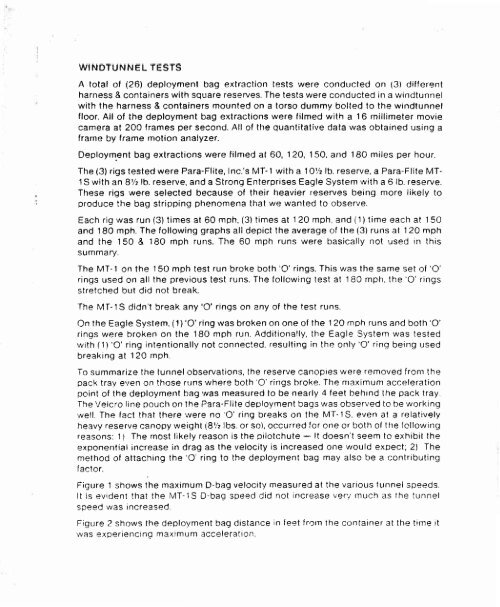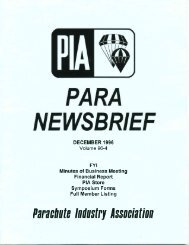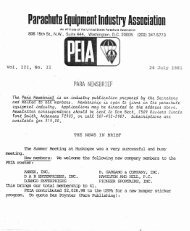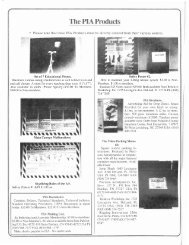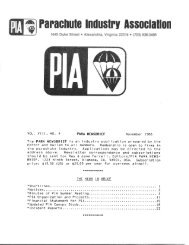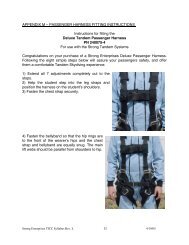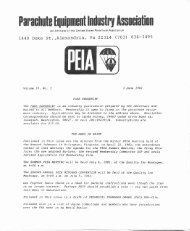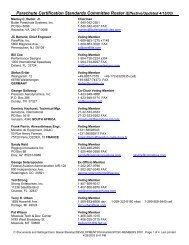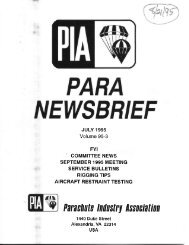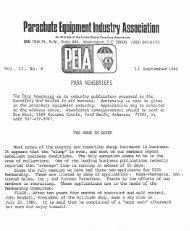Paracfiuln tquipmnnt Industry ilssnuiatiun - Parachute Industry ...
Paracfiuln tquipmnnt Industry ilssnuiatiun - Parachute Industry ...
Paracfiuln tquipmnnt Industry ilssnuiatiun - Parachute Industry ...
You also want an ePaper? Increase the reach of your titles
YUMPU automatically turns print PDFs into web optimized ePapers that Google loves.
WINDTUNNEL TESTS<br />
A total of (26) deployment bag extraction tests were conducted on (3) different<br />
harness & containers with square reserves. The tests were conducted in a windtunnel<br />
with the harness & containers mounted on a torso dummy bolted to the windtunnel<br />
floor. All of the deployment bag extractions were f ilmed with a 16 millimeter movie<br />
camera at 200 frames per second. All of the quantitative data was obtained using a<br />
frame by frame motion analyzer.<br />
Deployment bag extractions were lilmed at 60, 12O, 150. and 180 miles per hour.<br />
The (3) rigs tested were Para-Flite, Inc.'s MT-1 with a 1O1,/z lb. reserve, a Para-Flite MT-<br />
1 S with an 81/z lb. reserve, and a Strong Enterprises Eagle System with a 6 lb. reserve.<br />
These rigs were selected because of their heavier reserves being more likely to<br />
produce the bag stripping phenomena that we wanted to observe.<br />
Each rig was run (3) times at 60 mph, (3) times at 12Q mph, and (1)time each at 150<br />
and 180 mph. The following graphs all depict the average of the (3) runs at 120 moh<br />
and the 150 & 18O mph runs. The 60 mph runs were basically not used in this<br />
summary.<br />
The MT-1 on the 150 mph test run broke both 'O' rings. This was the same set of 'O'<br />
rings used on all the previous test runs. The f ollowing test at 180 mph. the 'O' rings<br />
stretched but did not break.<br />
The MI-1S didn't break any'O'rings on any ol the test runs.<br />
On the Eagle System, (1)'O'ring was broken on one of the 120 mph runs and both'O'<br />
rings were broken on the 180 mph run. Additionally, the Eagle System was tested<br />
with (1)'O'ring intentionally not connected, resulting in the only'O'ring being used<br />
breaking at 120 mph.<br />
To summarize the tunnel observations, the reserve canoples were removed f rom the<br />
pack tray e\.'en on those runs where both 'O' rings broke. The nraximum acceleration<br />
point of the deployment bag \Jvas measured to be nearly 4 feet behind the pack tray<br />
The Velcro line pouch on the Para-Flite deplgymgnl bags was observed to be working<br />
well. The fact that there,,vere no O'ring breaks on the MT'1S. even at a relatively<br />
heavy reserve canopy weight (872 lbs or so), occurred for one or both of the f ollowing<br />
reasons: 1) The most likely reason is the pilotchute<br />
-<br />
lt doesn t seem to exhibit the<br />
exoonential increase in drag as the velocity is increased one would e.\pect; 2) The<br />
method of attaching the 'O' ring to the deployment bag may also be a contributing<br />
f aclor.<br />
Figure 1 shows the maximum D-bag velocity measured at the various lunnel speeds.<br />
It is evident that the MT-1S D-baq speed did not increase ven/ much as the iunnel<br />
speed was increased<br />
Fiqure 2 shows the deployment bag distance in feet frorn the container at the tirne it<br />
was experiencing maximum acceleration


